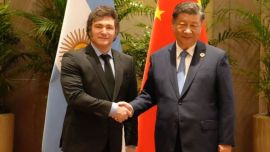Just over four months ago, Argentina marked the 25th anniversary of the AMIA Jewish communit y centre bombi ng, the deadliest terrorist attack in the country’s history.
The bombing of the Argentine Israelite Mutual Association centre took the lives of 85 and injured hundreds more. Its perpetrators, widely believed to be Hezbollah operatives backed by the support of Iran, have still never been brought to trial.
More than two decades on, anti-Semitism appears to be on the rise again in Argentina and across the world. A special commissioner from the United Nations recently reported global spikes in anti-Semitic acts, including violence, as well as inreased anxiety among Jewish communities.
The trend holds in Argentina where, according to a preliminary report by the Delegation of Argentine Jewish Associations (DAIA), the Jewish political umbrella organisation, anti-Semitic acts increased by 500 percent in 2018, with over 2,000 incidents reported. In 2017, that number stood at just 404.
Many of these attacks are now taking place online, a trend that’s true worldwide, making them harder to identify or control.
The Times spoke with Shimon Samuels, the director for international relations of the Wiesenthal Center, the Jewish human rights organisation which focuses on identifying, raising awareness of and addressing threats against the global Jewish community across the world.
How do you see anti-Semitism today, across the world?
In the 50 years I’ve been doing this, I’ve never seen a return to the phenomena that we know so well from the 1930s, which is only hardened and much more sophisticated today because of the Internet. When I met and started working with Simon Wiesenthal in 1988, he used to say ‘What starts with the Jews never ends with the Jews.’ That’s what’s happening today.
For example, terrorism, it’s basically anti-Semitic terrorism. Whether it was the first wave in Europe, the import of professional killers from the Middle East with local back-up from extremist organisations, or whether it was, as now, native-born French, for example, many of whom are radicalised through social media, many of whom come back from ISIS and their prime target is the Jews because that’s how they’ve been raised.
But little by little it’s becoming indiscriminate. This consortium is Jews, Christians, moderate Musilms, women, gays, you name it. The Jew is only part of it. The Jew will still be the privileged target but as it gets more and more indiscriminate, something has to happen on the part of the authorities.
Also, we have some unknown, unseen forms of antiSemitism. One is identification robbery. Take the Palestinian campaign in UNESCO. They try to validate their identity by claiming rights to certain places, including the Wailing Wall, a shrine for Jews, or the Church of the Nativity in Bethlehem, the seat of Christianity. It’s a battlefield.
Then, there’s what we’re seeing at book fairs and culture fairs worldwide. At book fairs, like the one in Frankfurt which has 300,000 people pass through it every year, we’ve seen the propagation of lots of books like Mein Kampf and pamphlets with conspiracy theories. This is a form of antiSemitism which you don’t read about in the newspapers generally, but it’s doing great damage. That’s an example of lowtech, which can be as bad as high tech.
When you open the key to anti-Semitism, you open the door to all other forms of bigotry.
Do you define anti-Semitism today differently than in the past?
There’s really no universally accepted definition. The International Holocaust Remembrance Alliance, of which Argentina is the only Latin American member, created a working definition in 2016 that defines it as a ‘certain perception of Jews’ and the ‘rhetorical and physical manifestations’ of those ‘directed toward’ individuals, their property, institutions or religious facilities.
A qualifying, but less obvious to some, example is BDS — the boycott and divestment sanctions — of the Jewish state. That can be directly transposed to a picture from the 1930s which says ‘you do not buy from Jews.’ There are photos from the Nazi-era of people smashing the Jewish store windows and destroying Stars of David. BDS is that, in real time today.
Another part is anti-Zionism, which is good camouflage for people who are just anti-Semitic. For 20 years, it was a crime. In the next 20 years, it was distasteful. Now, in these next 20 years, it’s moving from cocktail chatter to cocktail molotovs, or violence.
We’re seeing new forms of anti-Semitism always, like a dot of mercury that spreads in the heat and never goes away.
Globally, the rise of populism is allowing for new forms [of anti-Semitism]. There’s no centre, everyone’s moved to the extremes. Jews and other minorities are uncomfortable being on the extreme. In the US and in England, for examples, Jews historically were on the left. I didn’t leave the left, the left left me. We’re seeing what’s called ‘intercessionism’ — where groups that are “victims” are taking solidarity with the Palestinians. All of these intercessions building up have had a multiplying effect on anti-Semitism.
At the World Social Forum in Porte Alegre, for example, they carried signs that said ‘Vive la intifada mundial.’ They don’t know anything about the intifada, all they think they know is that Israelis killed Palestinians and that Jews of the past are not the Jews of today so they don’t have a claim to the state of Israel.
Is there a distinction between Judaism and Zionism?
Judiasim is composed of its own trinity — people, book, land. Every day, Jews pray for Jerusalem. Every year, at Passover, we say ‘Next year in Jerusalem.’ Every time you pray for your dead, you turn in the direction of Jerusalem. Zionism as a political movement is a late use of the word ‘Zion.’ You can’t split Zionism from Judaism, it’s just good camouflage.
Anti-Semitism is on the rise in Argentina, according to reports. What’s the future like for Jews in Argentina?
If this government is insensitive to Jewish issues, if the whole question of what was called the Memorandum [of Understanding, signed with Iran in 2013, under theCristina Fernández de Kirchner administration] comes back, then I think it will be a Jewish issue with very broad repercussions for the general public.
I don’t like to pre-judge any government, and I’m not Argentine. But I have been coming here since 1967, and I’m married to an Argentine. It’s a country that I admire. But, on the other hand, Argentina is in danger. Just like Chile is in danger because of demographics. But, in Argentina it’s not a question of demographics, but of ideology. The ideology is pseudo-Peronism.
But I think that there is grave concern in the international community.
Has the global community taken a wrong turn in teaching the Holocaust?
There’s a divide between those who look at the Holocaust with a view of universality versus particularity. Should it stand alone as one of the most serious forms of genocide or should it stand in a series of genocides?
Many universities or institutes are moving to the latter and true witnesses — survivors — are passing. When this goes into history, the lessons are surely there, but I don’t know what the answer is.
Then, with the teaching of
the Holocaust, it’s become politicised. For example, in France, teaching the inter-war period is mandated, not the Holocaust. Why? In schools with
high density of young Muslims, they don’t want to hear
that, and the French went
along with that. related news





















Comments